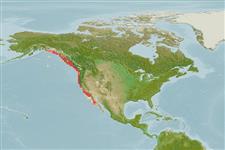Environment: milieu / climate zone / depth range / distribution range
Écologie
marin démersal; profondeur 9 - 547 m (Ref. 27437), usually 183 - ? m (Ref. 6885). Subtropical; 61°N - 27°N, 145°W - 113°W
Eastern Pacific: Yakutat Bay, Alaska to Rompiente Point, Baja California, Mexico.
Length at first maturity / Taille / Poids / Âge
Maturity: Lm 17.0, range 17 - ? cm
Max length : 38.0 cm TL mâle / non sexé; (Ref. 5483); âge max. reporté: 38 années (Ref. 39277)
Description synthétique
Clés d'identification | Morphologie | Morphométrie
Épines dorsales (Total) : 13; Rayons mous dorsaux (Total) : 12 - 14; Épines anales: 3; Rayons mous anaux: 5 - 8. Head spines strong to moderate - nasal, preocular, postocular, tympanic and parietal spines present, nuchals usually absent, supraocular and coronal spines absent (Ref. 27437). Eye large; 2 strong, sharp, hooked spines on lower margin of suborbital bone; 2nd anal fin spine longer than 3rd in depressed fin (Ref. 27437). Caudal fin moderately indented (Ref. 6885). Pinkish red to yellowish red, silvery ventrally; dusky saddles on back, may be vague; green streaks on caudal fin (Ref. 27437).
Mostly found in offshore water on soft bottoms (Ref. 2850). Ovoviviparous (Ref. 6885). Anterolateral glandular grooves with venom gland (Ref. 57406). Commonly caught with trawls but usually discarded because of its small size (Ref. 2850). Rarely taken on baited hook in deep water (Ref. 2850).
Ovoviviparous (Ref. 6885).
Eschmeyer, W.N., E.S. Herald and H. Hammann, 1983. A field guide to Pacific coast fishes of North America. Boston (MA, USA): Houghton Mifflin Company. xii+336 p. (Ref. 2850)
Statut dans la liste rouge de l'IUCN (Ref. 130435)
Utilisations par l'homme
Pêcheries: commercial; pêche sportive: oui
Outils
Articles particuliers
Télécharger en XML
Sources Internet
Estimates based on models
Preferred temperature (Ref.
123201): 5.9 - 8.3, mean 6.5 °C (based on 19 cells).
Phylogenetic diversity index (Ref.
82804): PD
50 = 0.5000 [Uniqueness, from 0.5 = low to 2.0 = high].
Bayesian length-weight: a=0.01000 (0.00499 - 0.02004), b=3.09 (2.92 - 3.26), in cm total length, based on LWR estimates for this Genus-body shape (Ref.
93245).
Niveau trophique (Ref.
69278): 3.7 ±0.5 se; based on size and trophs of closest relatives
Résilience (Ref.
120179): Faible, temps minimum de doublement de population : 4,5 à 14 années (K=0.06; tm=4; tmax=38; Fec=15,000).
Fishing Vulnerability (Ref.
59153): Low to moderate vulnerability (28 of 100).
